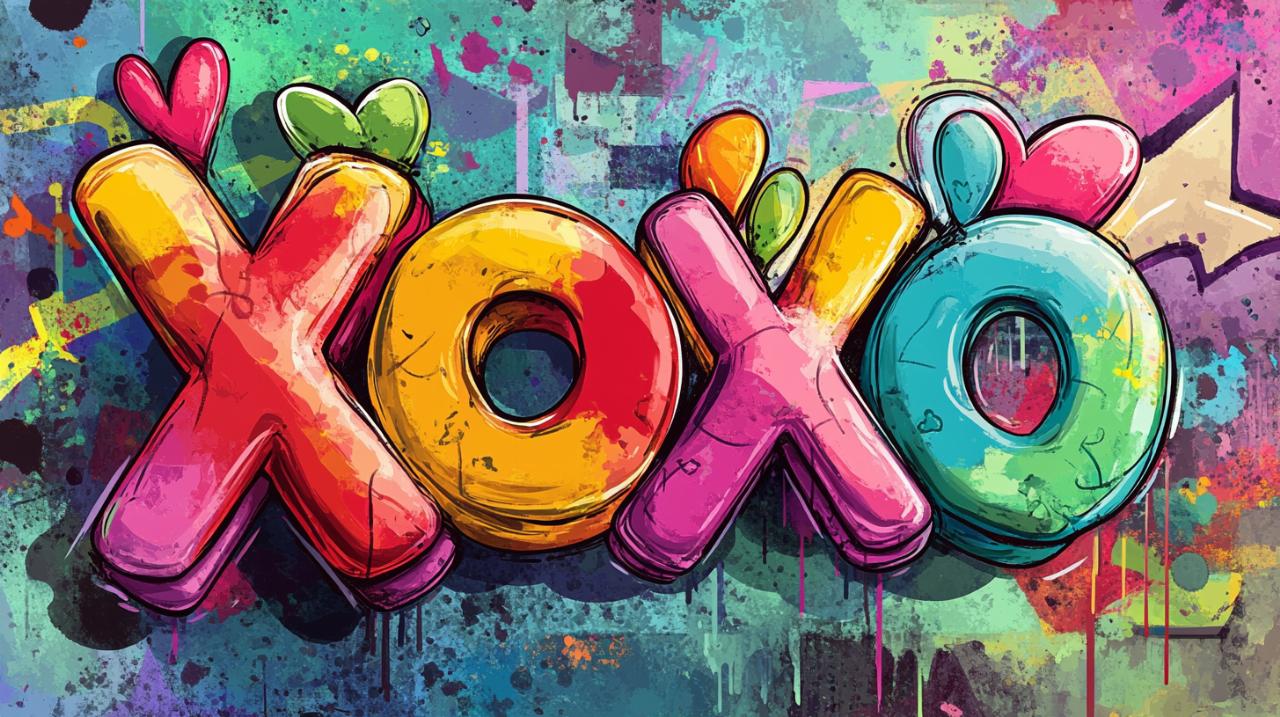When it comes to expressing affection in our increasingly digital world, few symbols have achieved the universal recognition and cultural staying power of XOXO. This seemingly simple combination of letters carries rich historical significance and nuanced meanings that vary across cultures. From casual sign-offs in text messages to heartfelt expressions in love letters, XOXO has woven itself into the fabric of how we communicate care and connection across distances both physical and emotional.
The Origins and Meaning of XOXO
XOXO stands for 'kisses and hugs', with the 'X' representing kisses and the 'O' symbolising hugs or embraces. This charming shorthand has become a staple in informal communication, but its roots stretch back much further than our digital age might suggest. The symbol has evolved over centuries to become the affectionate expression we recognise today.
Historical roots of X and O symbolism
The use of 'X' as a symbol for a kiss dates back to medieval times when many people were unable to write. These individuals would sign important documents with an 'X' and then kiss the mark as a display of sincerity and good faith—a practice that eventually evolved into the romantic association we have today. Christian symbolism also plays a role, as the 'X' resembles the Greek letter 'chi', which was used as an abbreviation for Christ, making the symbol a sacred one that represented faith and devotion.
The 'O' symbol has a somewhat murkier origin story, though many scholars believe it developed as a natural visual representation of an embrace or the encircling of arms around another person. Jewish immigrants arriving in America would often sign documents with an 'O' instead of an 'X', as they associated the 'X' with Christian symbolism, potentially contributing to the development of the 'O' as a distinct symbol in written communication.
Cultural interpretations across different societies
While XOXO has gained international recognition, its interpretation varies significantly across cultures. In British culture, the 'X' is commonly used at the end of messages between friends and family, regardless of gender, though multiple Xs might indicate a closer relationship. This casual use contrasts with American culture, where XOXO often carries more romantic connotations and might be reserved for closer relationships.
In some European countries like France, the tradition of 'la bise'—greeting with kisses on the cheek—mirrors the affectionate nature of the 'X' symbol. Meanwhile, in parts of Eastern Europe and Russia, three kisses might be represented as 'XXX', reflecting the traditional three-kiss greeting common in those regions. The widespread adoption of XOXO demonstrates how written symbols can transcend language barriers to communicate universal human emotions.
Xoxo in modern communication
The digital revolution has transformed how we express affection, with XOXO finding new life across various platforms. From text messages to social media posts, this symbol bridges the gap between traditional letter-writing and contemporary digital shorthand, adapting to new contexts while retaining its core meaning of affection.
Digital expressions of affection
In today's digital landscape, XOXO has become a versatile expression that appears in email signatures, text messages, and social media posts. The rise of emoji culture has even seen XOXO supplemented or sometimes replaced by heart symbols, kiss faces, and hug emojis that convey similar sentiments with added visual appeal. Despite these new options, many still prefer the classic charm and subtlety of the written XOXO.
Interestingly, the fashion and entertainment industries have embraced XOXO as a marketable concept, with the symbol appearing on clothing, accessories, and even as the title of the popular gossip blog in the television series 'Gossip Girl', which signed off each post with 'XOXO, Gossip Girl'. This commercialisation speaks to the symbol's cultural resonance and its association with intimacy, secrets, and close connections.
Generational differences in XOXO usage
How people use XOXO varies notably across generations. Baby Boomers and Generation X might use it more sparingly, often reserving it for close friends and family members. Millennials broadly adopted the expression in the early days of texting and instant messaging, sometimes using it liberally in their digital communications. Generation Z, meanwhile, has developed more nuanced approaches, sometimes ironically employing XOXO or integrating it into more complex digital expressions.
Research suggests that older generations tend to view XOXO as more meaningful and intimate, while younger users might see it as a casual sign-off without heavy emotional weight. This generational divide reflects broader changes in communication styles and demonstrates how symbols evolve in meaning over time, even as their basic form remains unchanged.
XOXO Around the World: From London to Tokyo
 The journey of XOXO across global cultures reveals fascinating adaptations and interpretations. While predominantly Western in origin, this symbol has found its way into international communication, often existing alongside local expressions of affection that reflect distinct cultural values and norms.
The journey of XOXO across global cultures reveals fascinating adaptations and interpretations. While predominantly Western in origin, this symbol has found its way into international communication, often existing alongside local expressions of affection that reflect distinct cultural values and norms.
Western versus Eastern interpretations
In Western contexts, particularly in the United Kingdom and the United States, XOXO generally maintains its meaning of hugs and kisses, though with varying degrees of intimacy implied. In London, a single 'X' frequently appears at the end of messages between casual acquaintances, while multiple Xs might signal closer friendship. This contrasts with American usage, where XOXO often carries more romantic connotations.
Eastern cultures have their own unique take on the symbol. In Japan, for instance, the expression 'XOXO' isn't commonly used in the same way. Instead, Japanese culture has developed its own digital expressions of affection, such as 'chu' (ちゅ) to represent a kiss sound or kaomoji (face emoticons) like '(っ˘з(˘⌣˘ )' to depict hugging or kissing. These differences highlight how expressions of affection are deeply tied to linguistic and cultural contexts.
Local alternatives to XOXO in global contexts
Around the world, various cultures have developed their own versions of affectionate sign-offs that serve similar functions to XOXO. In France, kisses are often represented by numbers in parentheses, like (2) for two kisses, corresponding to the traditional greeting of kissing both cheeks. Spanish-speaking countries might use 'besos y abrazos' or simply 'besos' to convey similar sentiments.
In South Korea, the character combination 'ㅋㅋㅋ' represents laughter rather than affection, but serves as a friendly, informal way to end messages. Chinese social media users might employ the character '么么哒' (mō mō dā) as a kissing sound, functioning similarly to XOXO in Western contexts. These regional variations demonstrate how the human desire to express affection in written form transcends cultural boundaries, even as the specific symbols used may differ.
The social etiquette of xoxo
Navigating when and how to use XOXO requires a certain social awareness. This seemingly simple symbol carries different connotations depending on the relationship between sender and recipient, the context of communication, and even workplace culture. Understanding these nuances helps avoid potential misunderstandings.
When is it appropriate to use XOXO?
The appropriateness of using XOXO depends heavily on the relationship and context. Between close friends and family members, XOXO generally feels natural and welcome. In romantic relationships, it can express affection without the weightiness of explicitly saying 'I love you'. However, in professional settings, XOXO typically crosses boundaries of workplace communication norms, particularly in more formal industries or when communicating with superiors.
Cultural context also matters significantly. In the UK, where adding an 'X' to messages is commonplace even between casual acquaintances, omitting it might actually be interpreted as coldness. Conversely, in more reserved cultures or professional American contexts, adding XOXO to a work email might be considered overly familiar or unprofessional. Being attuned to these subtle differences can help navigate social expectations successfully.
Potential misunderstandings and how to avoid them
The casual use of XOXO can sometimes lead to confusion about the sender's intentions. What one person intends as friendly affection might be interpreted as romantic interest by another, particularly when communication happens across cultural or generational boundaries. This potential for misinterpretation increases when people have different baseline expectations about how affection should be expressed.
To avoid such misunderstandings, it's helpful to consider the established pattern of communication in each relationship. Matching the tone and style of previous interactions provides a safe guideline. When in doubt, particularly in professional or new relationships, erring on the side of formality is usually wise. For those concerned about potential misinterpretation, alternative warm closings like 'Best wishes' or 'Kind regards' can convey friendliness without the potentially ambiguous connotations of XOXO. Understanding these subtleties ensures that our expressions of affection achieve their intended purpose of connection rather than creating confusion.
